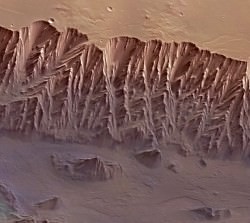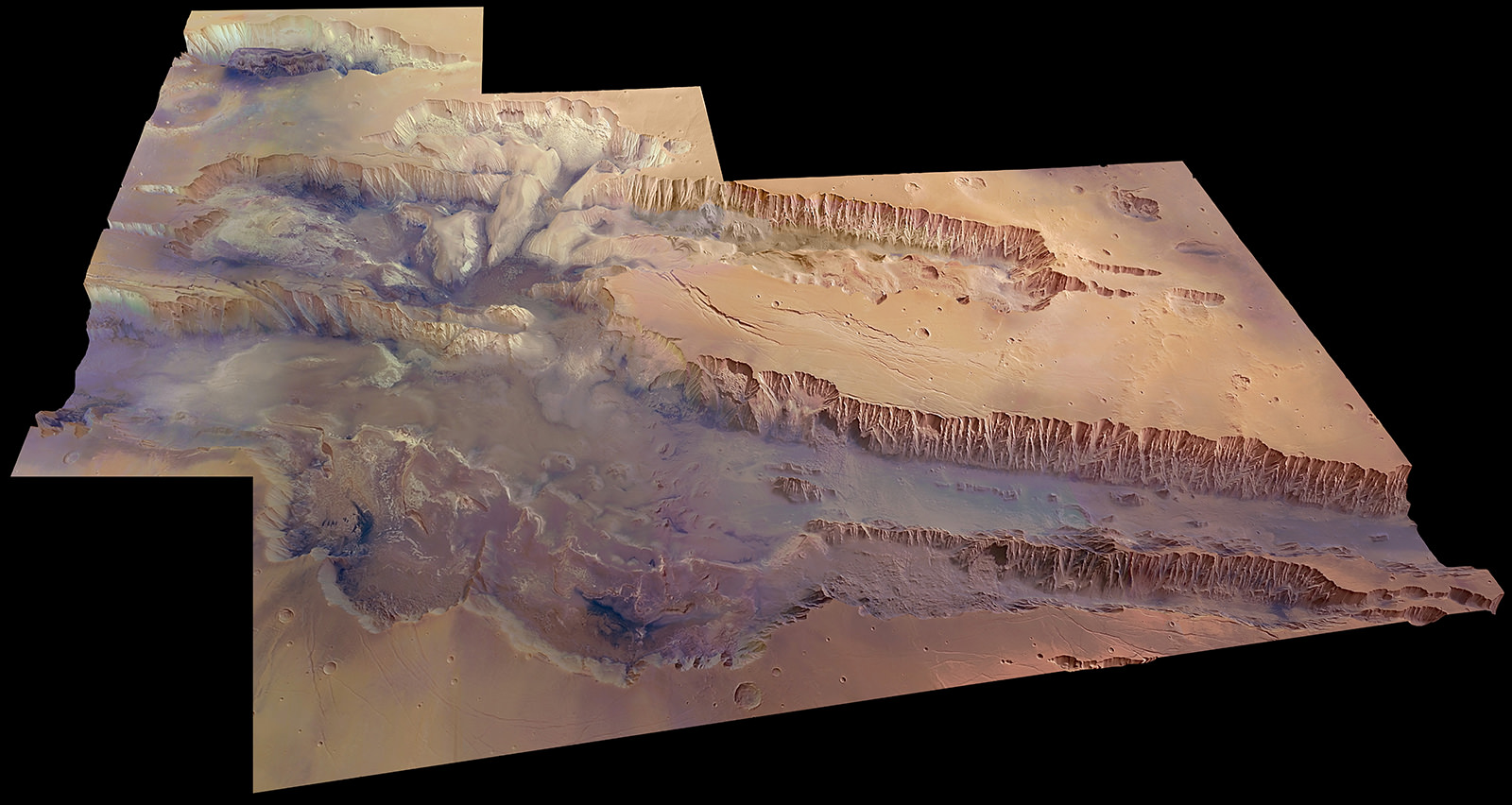A digital terrain model of a portion of Mars’ Valles Marineris, the largest canyon in the Solar System. Credit: ESA/DLR/FU Berlin (G. Neukum)
Anyone who’s visited the Grand Canyon in Arizona can attest to its beauty, magnificence and sheer sense of awe that comes upon approaching its rim, whether for the first time or hundred-and-first. “Grand” almost seems too inferior a title for such an enormous geological feature — yet there’s a canyon much, much bigger stretching across the surface of Mars, one that could easily swallow all of our Grand Canyon within one of its side gullies.
The image above, released online for the first time today by ESA, is a digital terrain model of a portion of Mars’ Valles Marineris: our Solar System’s grandest canyon.
 It’s easy to fall into hyperbole when describing Valles Marineris. Named for NASA’s Mariner 9 spacecraft, which became the first spacecraft to orbit Mars on November 14, 1971, the canyon is over 4000 km long, 200 km wide, and 10 km deep (2,480 x 125 x 6 miles) — that’s five times deeper than the Grand Canyon and long enough to stretch across the entire contiguous United States! It’s a rift unparalleled on any other world in the Solar System.
It’s easy to fall into hyperbole when describing Valles Marineris. Named for NASA’s Mariner 9 spacecraft, which became the first spacecraft to orbit Mars on November 14, 1971, the canyon is over 4000 km long, 200 km wide, and 10 km deep (2,480 x 125 x 6 miles) — that’s five times deeper than the Grand Canyon and long enough to stretch across the entire contiguous United States! It’s a rift unparalleled on any other world in the Solar System.
Valles Marineris is thought to be the result of the formation of the nearby Tharsis volcanic region, home to Olympus Mons, the Solar System’s largest volcano. As the region swelled with magma billions of years ago the planet’s crust stretched and split, collapsing into a vast, deep canyon.
 Much later, landslides and flowing water would help erode the canyon’s steep walls and carve out meandering side channels.
Much later, landslides and flowing water would help erode the canyon’s steep walls and carve out meandering side channels.
The 45-degree view above was was made from data acquired during 20 individual orbits of ESA’s Mars Express. It is presented in near-true color with four times vertical exaggeration (to increase relief contrast.) Download a high-res JPEG version here.
The largest portion of the canyon seen crossing left to right is known as Melas Chasma. Candor Chasma is the connecting trough to the north, and Hebes Chasma is in the far top left.
Below is a video released by JPL in 2006 showing a virtual fly-through of Valles Marineris, shown as if you were on a Grand Canyon-style helicopter sightseeing tour (that is, if helicopters could even work in the thin Martian air!)
Hopefully someday we’ll be seeing actual videos taken above Valles Marineris and photos captured from its rim… perhaps even by human explorers! (Please exit through the gift shop.)
Image source: ESA. Video by Eric M. De Jong and Phil Christiansen et. al, Arizona State University.


To my totally untrained eye, some of the holes in the upper righthand portion of the image look like sinkholes. Now we know what happened to the indigenous peoples of Mars. When their atmosphere began to evaporate, they moved underground and they didn’t support the ceiling of their city well enough.
Actually, the title of “Grandest Canyon” in our solar system ought to go to the Atlantic Ocean. It just happens to be filled with water, so it might not be that impressive visually.
My thinking was that the Marianes (sp?) Trench would be the grandest canyon on earth.
One of science fiction’s staples is air and moisture collecting at the bottom of this trench. Hope we get to find out.
A mighty hemispheric gash, dwarfing Earth’s largest dry Canyon, yet on a planet almost half Earth’s diameter! So, its even bigger than it looks.
Occurs to me, from eye-widening descriptions, and visuals, that even if, and when man arrives at Mars, it may be a long, long time before a astronaut comes to stand on one of that awesome Canyon’s dizzying rims. Assuming the first landing site might not be IN the Canyon.
Remembered something from the Moon missions, probably Apollo 17: Because there were no frames of reference (like trees on a distant rim, or down on the Grand Canyon floor, say), the astronauts had difficulty judging depth. A crater that was two kilometers away, and a 100 meters across, might have been smaller and nearer, or farther away and larger. If I recall, they could not really judge the SCALE of a feature too well, like Mount Hadley.
So, if an astronaut stood on VM’s rim, it might not be as impressive as one might think, because there would be no scale-determining point of reference.
Never saw the video. Wow! A masterful work of many minds and hands. Splendidly done, in every way! Its images and videos like these that put Universe Today near the top of my Astronomy list. And as here, good writing too.